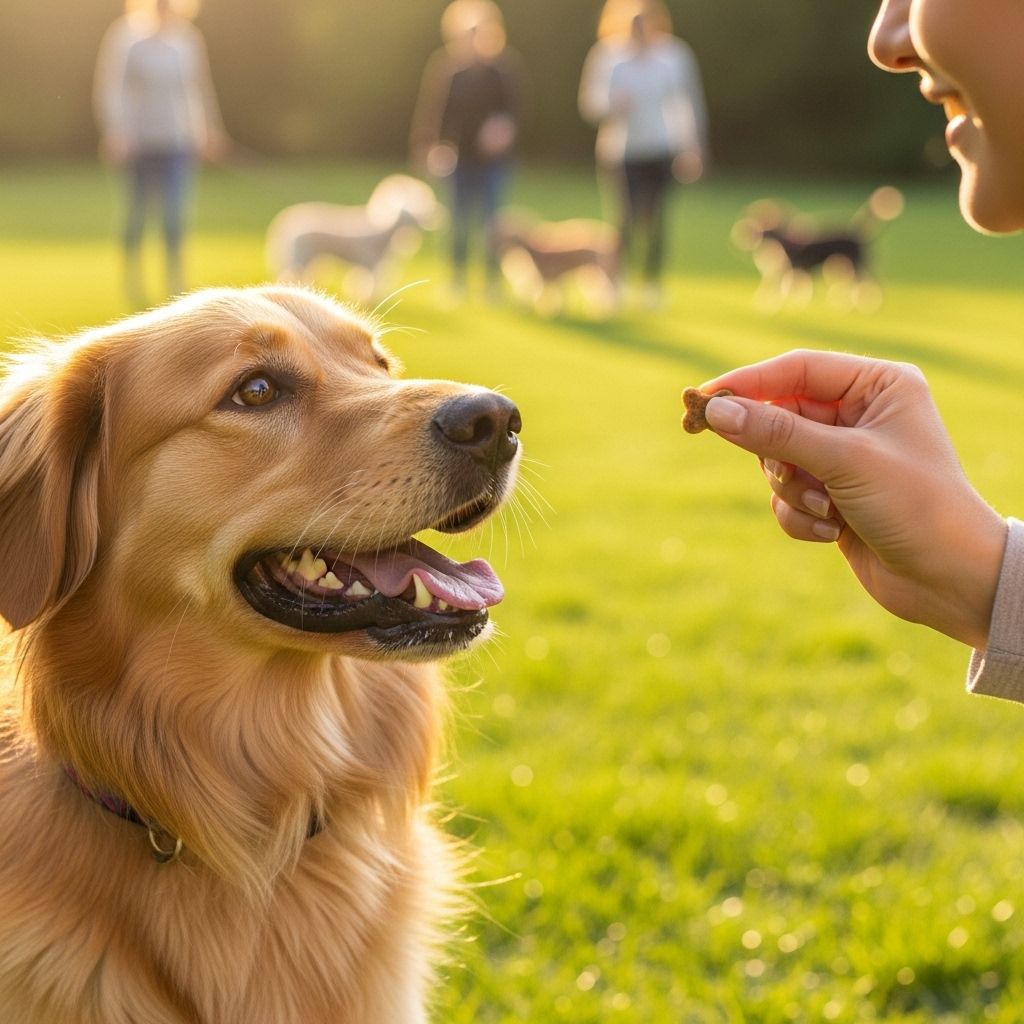Teach Your Dog to Speak: Step-by-Step Guide for Positive Barking on Command
Reward natural barks to cultivate clear, controlled communication.

Image: HearthJunction Design Team
Teach Your Dog to Speak: A Step-by-Step Guide
Barking is an instinctive behavior for dogs, but teaching your pet to bark on command—the speak cue—can be both a fun trick and a practical communication tool. Whether it’s to impress friends or to encourage your dog to voice their needs, learn how to harness this natural instinct using positive, expert-approved techniques. This comprehensive guide breaks down the process, offers troubleshooting strategies, and shows you how to maintain good manners throughout.
Table of Contents
- Why Teach Your Dog to Speak?
- Step-by-Step: Teaching the Speak Command
- Adding Hand Signals to the Speak Cue
- Expert Tips for Successful Speak Training
- Real-Life Uses for the Speak Command
- Teaching Quiet: Pairing Speak with Silence
- Frequently Asked Questions
Why Teach Your Dog to Speak?
Teaching your dog to bark on cue is much more than a party trick. The speak command can help you:
- Channel natural barking behavior in a controlled way
- Improve communication so your dog can alert you to needs (such as wanting to go outside)
- Build a stronger bond with your dog through positive training
- Lay the foundation for teaching your dog to be quiet on cue
- Provide mental enrichment and engagement
By training your dog to bark purposefully, you reduce nuisance barking and help your dog understand when it’s appropriate to make noise.
Step-by-Step: Teaching the Speak Command
The key to teaching “speak” is to capture a natural bark and mark it with a positive reinforcement technique, rewarding your dog only when they bark on cue. Patience and consistency are essential for best results.
Preparation
- Prepare high-value treats—small, soft, and very motivating snacks.
- Have a clicker ready if you use clicker training, or be ready to clearly say “Yes!” as a marker for correct behavior.
- Choose a quiet location free from distractions.
Step 1: Get Your Dog Excited
Since barking is a natural dog behavior, the challenge is encouraging a single, controlled bark. Try one of these methods:
- Knock on a table or door (if this usually gets your dog barking).
- Use a favorite toy or play to spark excitement.
- Jump around, clap, or get animated to increase your dog’s arousal.
As soon as your dog lets out a bark, immediately say your marker word (“Yes!”) or click, and give a reward.
Step 2: Add the Verbal Command
- Once your dog reliably barks in response to the stimulus, introduce your cue word (e.g., “Speak!” or “Bark!”) right before the action.
- Say “Speak!” then knock, jump, or use your chosen trigger.
- When your dog barks, immediately mark and reward.
Repeat this sequence several times until your dog begins to associate the word with the action.
Step 3: Fade the Prompt
- Gradually phase out the physical stimulus (e.g., no more knocking or jumping).
- Rely on just the cue word to elicit the behavior.
- Reward each correct bark on cue. If your dog doesn’t bark the first few tries, reintroduce the prompt then quickly try again with only the verbal command.
Step 4: Reward Only the Right Response
- Only reward single barks to prevent your dog from thinking “speak” means to go on a barking spree.
- If your dog keeps barking, wait until they stop, then ignore further barks and try again for a single response.
Step 5: Generalize the Cue
- Practice in new locations and with increased distractions so that your dog learns “speak” applies everywhere—not just one room.
- Gradually increase the distance between you and your dog as they learn.
Adding Hand Signals to the Speak Cue
Once your dog understands the verbal “speak” command, you can add a hand signal for silent communication or to enhance your dog’s understanding.
Common hand signal for speak:
- Hold your hand open with palm facing your dog.
- Repeatedly close your four fingers against your thumb, mimicking a talking mouth.
- Show this signal as you say the verbal cue.
With repetition, your dog will start responding to just the gesture, allowing you to cue barking quietly when needed.
Expert Tips for Successful Speak Training
Barking is a natural but sometimes overenthusiastic behavior. Use these expert tips for a successful, well-mannered bark on command:
- Be consistent: Always use the same cue word, tone, and hand gesture. Consistency avoids confusion and speeds up learning.
- Mark and reward only the behavior you asked for. Ignoring random barks helps your dog realize that only cued barking gets rewarded.
- Keep training sessions short (5-10 minutes) to avoid overstimulation and frustration.
- Respect your environment: Consider your neighbors, especially in apartments or shared walls. Keep barking sessions brief and controlled.
- Use a calm but upbeat tone—never scold for barking during training, or you may create confusion.
- If your dog is struggling, return to a previous training stage and practice more before progressing.
- Never encourage excessive or nuisance barking; reward only single, controlled barks.
Real-Life Uses for the Speak Command
The speak command is not just for show! It can serve several practical purposes in daily life:
- Let you know your dog needs something: Teach your dog to “speak” at the door when they need to go outside.
- Alert you to strangers or dangers in a controlled way.
- As groundwork for advanced tricks: Once your dog masters “speak,” you can teach volume control (“whisper”) or combine it with other tricks.
- Facilitate further obedience training: Understanding “speak” can help when teaching your dog to be quiet on cue.
Teaching Quiet: Pairing Speak with Silence
One of the top benefits of training “speak” is that it sets the stage for teaching your dog the opposite: to be quiet on command. As your dog learns to bark on cue, you can teach them to stop barking in the same session.
How to Teach “Quiet”
- When your dog barks on cue, use a marker and reward.
- After a single bark, say “Quiet!” with a calm, firm voice and show a hand signal (e.g., a raised index finger).
- If your dog stops barking, mark and reward.
- Repeat, gradually increasing the length of silence before rewarding.
Pairing these cues gives you more control and can reduce overall nuisance barking significantly.
Frequently Asked Questions (FAQs)
Do all dogs learn the speak command at the same speed?
No, breeds and individual dogs vary in enthusiasm for barking, energy levels, and trainability. Be patient and adjust training to your dog’s pace.
How do I prevent my dog from barking excessively during training?
Reward only single barks, ignore or redirect nuisance barking, and consider teaching “quiet” alongside “speak.” Keep sessions brief to avoid overstimulation.
Is it safe to teach a puppy to bark on command?
Yes, but puppies may be more excitable, so focus on calm, controlled sessions and never reward frantic or excessive barking.
What are good alternatives if my dog doesn’t bark easily?
Try other vocalizations like a “woof,” “whine,” or “growl.” Capture and reward whichever sound your dog is willing to offer.
Can I use the speak command to help with dog sports or service work?
Absolutely! In some sports and service jobs, controlled barking can signal needs or alert handlers to specific situations.
Should I worry about my neighbors while training “speak”?
Yes, always consider your environment. Train during reasonable hours and in short sessions. If needed, use spaces where barking won’t disturb others.
Bonus: Using Technology to Teach Dogs to Talk
For those who want to take communication even further, some trainers use speech buttons that dogs can press to “say” specific words. While this goes beyond traditional bark-on-command tricks, it showcases the versatility of positive training and creative ways to use your dog’s speaking ability.
Summary Table: Key Speak Training Steps
| Step | What to Do | Goal |
|---|---|---|
| 1. Capture Bark | Encourage and reward a natural bark | Expose natural instinct |
| 2. Add Cue | Say “Speak” plus prompt, then reward on bark | Associate cue with behavior |
| 3. Fade Prompt | Remove trigger, rely on the cue | Solidify verbal control |
| 4. Use Hand Signal | Add gesture, pair with cue | Enable silent cues |
| 5. Proof Cue | Practice everywhere | Achieve reliability in any setting |
Final Tips for Responsible Speak Training
- Be patient—never punish mistakes, just redirect and try again.
- End each session on a positive note, even if progress is slow.
- Remember: the goal is clear, controlled communication, not increased overall barking!
Further Resources
- Check American Kennel Club’s additional resources on basic dog training tips and fun tricks.
- Ask a professional trainer for personalized advice, especially if you encounter persistent barking issues.
References
- https://www.akc.org/expert-advice/training/train-your-dog-to-speak/
- https://www.akc.org/expert-advice/training/expert-tips-for-dog-training/
- https://www.akc.org/expert-advice/training/how-to-teach-your-dog-to-talk/
- https://www.akc.org/sports/herding/articles/speak-softly/
- https://www.youtube.com/watch?v=kUwo32kYldw
Read full bio of Shinta












